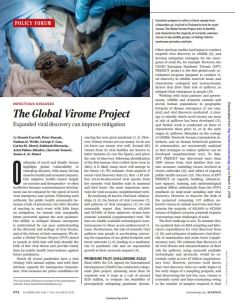
Dennis Carroll, Peter Daszak, Nathan D. Wolfe, George F. Gao, Carlos M. Morel, Subhash Morzaria, Ariel Pablos-Méndez, Oyewale Tomori and Jonna A. K. Mazet
The Global Virome Project
Expanded Viral Discovery can Improve Mitigation
Science, 2018
What's inside?
The Global Virome Project’s mission? Stop the next HIV-like pandemic before anyone is infected.
Recommendation
What you don’t know can kill you. Case in point: Deadly pathogens like HIV and Ebola were once viruses infecting only wild animals, of which humans were blissfully unaware. That’s why researcher Dennis Carroll and his colleagues lay out their rationale for the launch of the Global Virome Project (GVP), an ambitious billion-dollar plan to identify hundreds of thousands of potentially pandemic viruses in their animal hosts, before the next outbreak. getAbstract recommends this article to anyone who needs reassurance that viral experts are ready to step up the fight against pandemic diseases.
Take-Aways
- The vast majority of potentially deadly zoonotic viruses have not yet been discovered.
- The goal of the Global Virome Project (GVP) is to identify dangerous zoonotic viruses in their animal hosts before they infect their first human host.
- A pilot program started in 2009 uncovered 1,000 viruses with the characteristics of pandemic viruses.
- The GVP aims to identify 71% of the most dangerous zoonotic viruses over the next 10 years at a cost of $1.2 billion.
- If the GVP is able to prevent one pandemic viral outbreak, it could save many human lives and tens of billions of dollars.
Summary
The vast majority of deadly zoonotic viruses have not yet been discovered.
Many infamous viruses – including HIV, Ebola and SARS – are zoonotic diseases: animal viruses with the capacity to leap to humans. Historically, humans only notice these dangerous microbes once they start infecting us and triggering outbreaks. Ominously, hundreds of thousands of undiscovered zoonotic viruses still lurk in the animal world and could easily be the source of future pandemics. Some 631,000 to 827,000 unknown viruses have this potential. Given the broad human global footprint, and the frequency with which people travel, these viruses pose greater risks than ever. If people are not prepared for potential pandemics, the human and economic impact will be immense.
The goal of the Global Virome Project (GVP) is to identify zoonotic viruses before they infect their first human host.
Fighting viruses only after they cause disease is obviously not ideal. The newly announced Global Virome Project plans to get ahead of the problem by identifying dangerous zoonotic viruses in their animal hosts before they infect their first human host. This approach involves improving research and diagnostic infrastructure in many developing countries. Armed with this knowledge, health officials will have much more data to inform the development of medications and vaccines, as well as to aid in the management of domestic animals and wildlife that might harbor a pandemic virus. As of now, human beings lack ways to address the vast array of unknown viruses.
A pilot program started in 2009 uncovered 1,000 viruses with the characteristics of pandemic viruses.
The US Agency for International Development (USAID) launched a 35-country, $170 million pilot project in 2009 dubbed the Emerging Pandemic Threats (EPT) PREDICT. So far, EPT PREDICT has uncovered 1,000 viruses with characteristics of pandemic viruses. Along the way, USAID researchers learned valuable lessons, including how to forge healthcare alliances across borders, to institute training protocols and to analyze large volumes of data. Over the last two years, a worldwide team with representatives from non-profits, universities, governments and industry across the world have worked together to expand those efforts to create the GVP. They designed the financing and governance of the GVP as well as equitable policies that will make data easily available worldwide.
The GVP aims to identify 71% of the most dangerous zoonotic viruses over the next 10 years at a cost of $1.2 billion.
71% of zoonotic viruses, including those that are most common and therefore most likely to infect humans, could be identified within 10 years at an estimated cost of $1.2 billion. With the expense of both necessary field and laboratory work, the cost of identifying all dangerous viral threats, in the region of $7 billion. However, the early stages of viral discovery are considerably less costly. The rare viruses discovered in the later stages of research require more time in the field and laboratory in order to properly confirm. Rare viruses are unlikely to cause pandemics, so the broad focus on the earlier and less costly stages of research will incur significant public health and economic benefits.
If the GVP is able to prevent one pandemic viral outbreak, it could save many human lives and tens of billions of dollars.
If the GVP results in the prevention of one future large disease outbreak, it could save countless lives and would more than justify its price tag. For example, the SARS epidemic is estimated to have cost around $20 billion. The accelerated pace of the identification of new, dangerous viruses will make preparedness for pandemics greater and more informed. In addition, it would encourage innovation in preparedness for future pandemics and well as for new therapies. It would also significantly impact regions most vulnerable to pandemics, and may also help control diseases endemic to those regions. Fieldwork for the GVP will begin in China and Thailand in 2018.
About the Authors
Dennis Carroll, Peter Daszak, Nathan D. Wolfe, George F. Gao, Carlos M. Morel, Subhash Morzaria, Ariel Pablos-Méndez, Oyewale Tomori and Jonna A.K. Mazet are an international team of researchers working for the Global Virome Project.
This document is restricted to personal use only.
My Highlights
Did you like this summary?
Read the articleThis summary has been shared with you by getAbstract.
We find, rate and summarize relevant knowledge to help people make better decisions in business and in their private lives.
Already a customer? Log in here.
















Comment on this summary